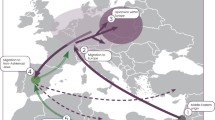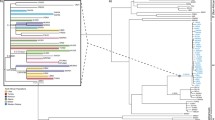Abstract.
DNA variation on the non-recombining portion of the Y chromosome was examined in 610 male samples from 14 global populations in north, east, and southeast Asia, and other regions of the world. Eight haplotypes were observed by analyses of seven biallelic polymorphic markers (DYS257 108, DYS287, SRY 4064, SRY 10831, RPS4Y 711, M9, and M15) and were unevenly distributed among the populations. Maximum parsimony tree for the eight haplotypes showed that these haplotypes could be classified into four distinct lineages characterized by three key mutations: an insertion of the Y Alu polymorphic (YAP) element at DYS287, a C-to-G transversion at M9, and a C-to-T transition at RPS4Y 711. Of the four lineages, three major lineages (defined by the allele of YAP+, M9-G, and RPS4Y-T, respectively) accounted for 98.6% of the Asian populations studied, indicating that these three paternal lineages have contributed to the formation of modern Asian populations. Moreover, phylogenetic analysis revealed three monophyletic Asian clusters, which consisted of north Asian, Japanese, and Han Chinese/southeast Asian populations, respectively. Coalescence analysis in the haplotype tree showed that the estimated ages for three key mutations ranged from 53,000 to 95,000 years, suggesting that the three lineages were separated from one another during early stages of human evolutionary history. The distribution patterns of the Y-haplotypes and mutational ages for the key markers suggest that three major groups with different paternal ancestries separately migrated to prehistoric east and southeast Asia.
Similar content being viewed by others
Author information
Authors and Affiliations
Additional information
Electronic Publication
Rights and permissions
About this article
Cite this article
Tajima, A., Pan, IH., Fucharoen, G. et al. Three major lineages of Asian Y chromosomes: implications for the peopling of east and southeast Asia. Hum Genet 110, 80–88 (2002). https://doi.org/10.1007/s00439-001-0651-9
Received:
Accepted:
Published:
Issue Date:
DOI: https://doi.org/10.1007/s00439-001-0651-9




